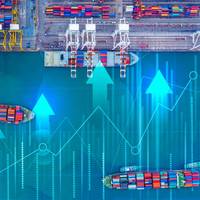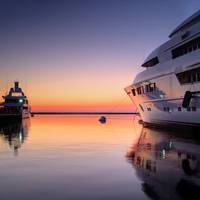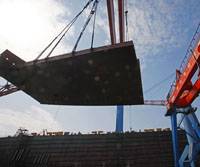'Free Money' is Over, but Shipping Finance is Positive

Shipping finance markets for the rest of 2023 look positive, with a depth of lenders, banks, leasing houses and alternative credit funds all seeking to grow their portfolios and offer the best terms to win projects; and competition between lenders in the improving tanker markets is especially fierce, says a recent survey from oceanis.While financing volumes available for each individual vessel have plateaued as asset values rose over the past quarter, margins have been under severe downward pressure as banks have started to explore financing cases further from their previous comfort zones.
OET Acquires ECO Suezmax Tanker Pair
Greek shipping company Okeanis Eco Tankers (OET) intends to exercise an option to acquire two ECO scrubber-fitted Suezmax tankers under construction at South Korean Hyundai Samho Heavy Industries.Okeanis will spend almost $130m to buy the two 158,000 dwt scrubber-fitted vessels from its chief executive Ioannis Alafouzos' private company.As Suezmax values have risen and newbuilding delivery timelines extended into 2021 in the period since its granting, the option is presently well in-the-money and accretive to NAV.In addition, with the recent dramatic firming of the tanker spot and time charter markets and the availability of low cost…
Belships Gets USD140Mln to Expand Fleet
Norway's dry bulk owner Belships Group has secured a USD 140 million loan facility. The loan replaces the Group's current senior debt of USD 105 million.The new loan will be available in two tranches, said a press release from the bulk ship operator and management company. An initial tranche of USD 110 million will replace Belships existing loan and strengthen the Group's working capital. An accordion tranche of USD 30 million will be available for fleet expansion.Following the merger with Lighthouse Group in December 2018, Belships currently owns twelve supramax and ultramax dry bulk vessels. In addition, the Group operates three ultramax on time and bareboat charter with purchase options.
How Much is That Superyacht Worth?

Sam Tucker Will Tell You! There’s a new name in Superyacht valuation, and the name is VesselsValue.com. Last month we spoke with VesselsValue.com’s Sam Tucker for insights on its new Superyachts report. Many of our readers know VessselsValue, but for those who do not, please provide a brief description of the organization and its offering. Launched in 2011 by Richard Rivlin, a ship broker with 40 years of buying and selling experience, VesselsValue provides daily and automated Market…
Navy Autonomous Underwater Vehicle Delivery Milestone
Commander, Submarine Development Squadron 5 (CSDS 5), Detachment UUV, informs of the delivery of Large Training Vehicle 38 (LTV 38), an unmanned undersea vehicle (UUV), which makes LTV 38 the first UUV to join the vehicle inventory used by detachment UUV at Naval Undersea Warfare Center Keyport. LTV 38 is able to perform at a maximum depth of 1,000 meters for up to 72 hours. It is designed as a full-pressure hull vehicle, capable of both line of sight and over the horizon communications, and can also conduct limited autonomous contact avoidance maneuvers via acoustic sensors while anchored and such missions are conducted and controlled remotely.
2010 and the Rise of Sinopacific Shipbuilding Group

It might be hard to judge now if the global shipbuilding industry is recovering, but an encouraging story is certainly taking place in China in 2010. According to Clarkson Research Services, China overtakes Korea as the world's top shipbuilder in the first half of 2010 and kept ahead in terms of three major industry indicators, including new orders, order backlogs and delivery. As China’s leading private shipbuilding company, Sinopacific Shipbuilding Group is a significant driving engine of the industry development and made a rapid growth in the past year.
Sinopacific Shipbuilding Applies New LTV Concept
A growing global focus on the low carbon economy has sparked greater awareness of the low-carbon trend among shipbuilders. Recently various international maritime conventions and standards, such as the convention on greenhouse gas emissions, PSPC and Ballast Water Management, have been issued that greatly impact the global shipbuilding industry. Many shipbuilding companies are investigating new approaches to reducing fuel consumption, carbon emissions and operating costs, to enhance safety and achieve environmentally neutral operation while maintaining ship speed and increasing load capacity. To meet this objective, Sinopacific Shipbuilding Group recently proposed a new Load-to-Value (LTV) concept, a load efficiency factor that indicates such trend in the shipbuilding industry.
U.S Flag Lakers - Steel Slowdown Apparent
The downturn in steel production impacted U.S.-Flag lakers’ November iron ore float. The fleet moved 3.9 million net tons of iron ore in November, a decrease of 3.2 percent compared to a year ago, and a drop of 8.8 percent compared to the month’s 5-year average. Not one iron ore cargo was transshipped in November, as the steel mill in Cleveland, Ohio, has idled its blast furnaces. The last time the iron ore trade on the Cuyahoga River was silent during the shipping season was in 2001 when LTV Steel was facing extinction. The decrease in iron ore cargos in November was actually greater than the totals suggest. The fleet experienced significant weather-related delays in November of 2007. The 4 million net tons that moved a year ago were not indicative of demand.
Slight Increase in U.S.-Flag Carriage In November
U.S.-Flag lakers hauled 11 million tons of various dry-bulk cargos in November, a slight increase (1.8 percent) compared to last year. With now five straight months of increases, U.S.-Flag carriers have moved nearly 91 million tons of cargo and narrowed the gap between this and last year to 2.2 percent. Iron ore shipments in U.S. bottoms totaled 5 million tons in November, an increase of nearly 17 percent. However, as has been stated before, increases in the ore float are not as impressive as they seem. LTV Steel was in its death throes a year ago; ISG has relit most of LTV's blast furnaces with a resulting increase in demand for iron ore. For the season, U.S.-Flag iron ore cargos stand at 41.8 million tons, a decrease of 1.7 percent.
NEWS:U.S.-Flag Carriage Down Again In 2002
U.S.-flag Great Lakes vessels hauled 101.3 million tons of cargo in 2002, a slight decrease compared to 2001. Even the one gain - 1.2 million tons of iron ore - is misleading. During 2001, LTV Steel, the nation's third largest producer, was continually reducing its iron ore requirements as it limped toward bankruptcy and then closure. ISG relit those blast furnaces in mid 2002, so the upturn reflects a resumption of production at those facilities in Ohio and Indiana. In reality, the 48.2 million tons of iron ore moved in U.S. bottoms in 2002 represent a decrease of 24 percent compared to 1997. It was in that year that foreign steelmakers, facing contracting markets in Asia, began dumping their excess production in the United States.
Feature: Leaving Home
For many years the fortunes of the Great Lakes-based shipbuilders and naval architects was based solidly on the building level of the owners who were also based on the 94,000 sq. mi. of water that makes up the five Great Lakes. That is no longer as true a statement as it once was. While there are many projects in this area designed and build by Great Lakes firms for owners in the area, an impressive number of significant commercial market projects as varied as Staten Island, New York ferries and Gulf of Mexico crew/supply boats were designed and or built on the Great Lakes. The Kennedy Class of double ended auto/passenger ferries is one of the most recognizable images of New York City. Every weeknight millions of people see one during the opening of the David Letterman Show.
News: Lakes Shipping Down 1.4 Percent in 2002
Dry-bulk cargo movement on the Great Lakes totaled 162.3 million net tons in 2002, a decrease of 1.4 percent compared to 2001 and a drop of 6 percent compared to the 5-year average. Iron ore shipments totaled 58.9 million net tons in 2002, an increase of 5.8 percent compared to 2001, but a decrease of 9.2 percent compared to the 5-year average. North American raw steel production totaled an estimated 101.7 million tons in 2002, an increase of 2.4 percent compared to 2001, but the amount of steel made in Basic Oxygen Furnaces that turn pellets into hot metal fell 4 percent to an estimated 50.1 million net tons. The Lakes iron ore trade was essentially non-stop in 2002.









